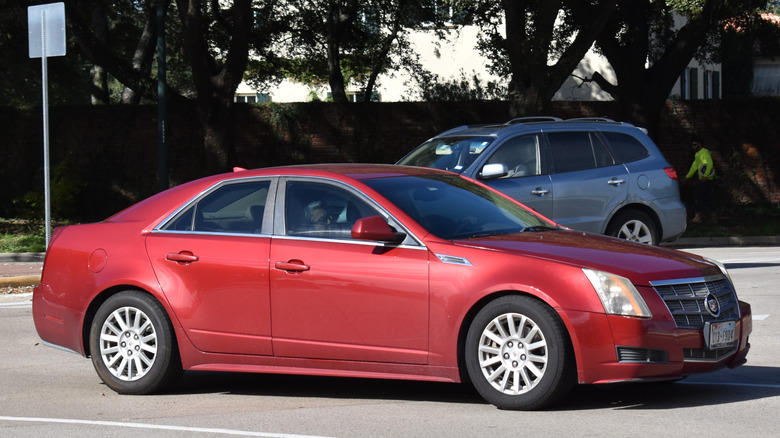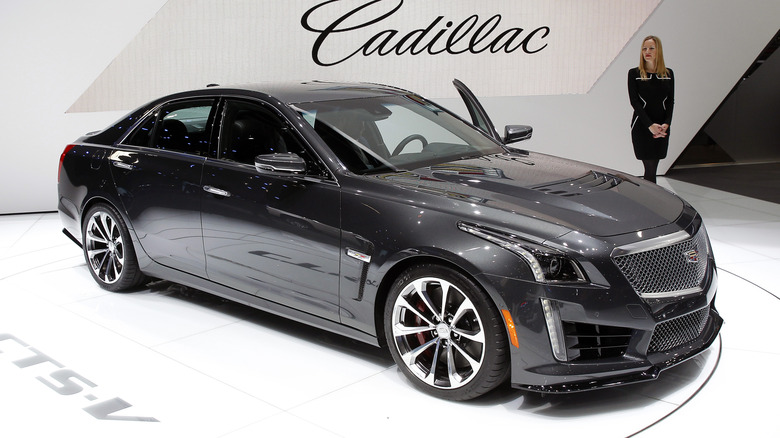What Does CTS Stand For On A Cadillac?
As of this publication, Cadillac's lineup comprises a mix of badges, from the stalwart Escalade to the alphabet soup-inspired XT6. While new nameplates like the Lyriq and Optiq have joined the stable, the automaker once leaned heavily on letter-based names like the CTS. This midsize sport sedan debuted for the 2003 model year and was sold through 2019. The CTS designation comes from Catera Touring Sedan, a reference to the short-lived four-door Cadillac offered in the late 1990s. The original Catera earned a reputation as one of the worst-selling American cars, and Cadillac knew a replacement had to make a stronger impression.
The CTS launched with sharp, angular styling, a rear-wheel-drive platform, and engineering aimed squarely at European rivals. Cadillac followed it up in 2004 with the CTS-V, the first model in its V-Series performance line, which continues as of 2025. Across three generations, the CTS served as Cadillac's primary midsize sport sedan and a competitor to German brands in the luxury segment.
The meaning behind CTS: Catera Touring Sedan
CTS stands for Catera Touring Sedan, a name that pointed back to Cadillac's first real try at a European-style luxury car. The Catera, sold from 1997 to 2001, was essentially a rebadged Opel Omega, a rear-wheel-drive sedan built by General Motors' German division. Cadillac brought it over from Europe and marketed the Catera as an affordable entry-level option for buyers who might otherwise pick a BMW 5 Series or Mercedes E-Class. The Catera never earned its stripes as a high-performance Cadillac model.
While the idea of offering a smaller, more nimble sedan was sound, the execution fell short. The Catera's soft suspension, middling power, and uninspired styling failed to sway buyers. In its final year, fewer than 10,000 Cateras were sold.
When the CTS launched, Cadillac kept the "C" in the name as a subtle link to the Catera, but made it clear this was a more serious effort. The CTS rode on an all-new platform with a stiffer chassis and sharper handling, deliberately benchmarked against BMWs. Its angular styling was a dramatic break from the past as Cadillac sought to directly take on German sport sedans.
Why the CTS name mattered for Cadillac
The arrival of the 21st century marked a turning point for Cadillac as younger buyers drifted towards BMW, Mercedes-Benz, and Lexus. GM's luxury brand was losing relevance as shoppers gave up on luxobarges in favor of engaging and dynamic sport sedans. The CTS was engineered to change these perceptions via distinctive styling and engaging handling.
Straightline performance would come later, as the CTS debuted with a 220-horsepower 3.2-liter V6 under the hood. An optional 3.6-liter V6, making 260 ponies, arrived in 2004. That same year, the CTS-V hit the street with an LS6 V8 producing 400 horsepower, seeking to challenge the BMW M3 and Mercedes-AMG C63. The final year of the CTS-V came in 2019 with a supercharged 6.2-liter V8 cranking out 640 horsepower—one of the highest horsepower Cadillacs ever made.
The CTS also introduced Cadillac's "Art and Science" design language, with its crisp lines and angular profile, which became a brand signature for almost two decades. The styling approach was used on other Cadillacs, including the XLR convertible and the SRX crossover. Even the Escalades of that era adopted CTS-inspired, chiseled elements.


